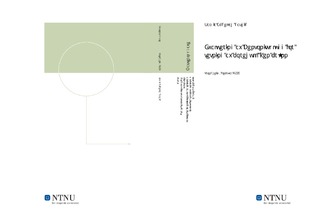| dc.description.abstract | The basic technologies associated with the plugging and abandoning of wells has not changed significantly since the 1970s. Water-based slurries of cement and drilling mud are still the basic materials used to plug most wells although progress has been made in use of additives to customize the cements and muds for specific types of wells. The maturation of the oil and gas industry worldwide is resulting in a large number of idle and orphaned wells in addition to the ever increasing number of wells waiting to be abandoned. The need for reliable and cost effective means of well abandoning technology has never been more acute. In the search for new plugging materials, bentonite has been acknowledged as possibly the ideal alternative material.In this thesis, bentonite has been evaluated as an alternative sealing material to cement for plug and abandonment of wells. The sealing properties of bentonite and barite has been investigated and put to test. Attempts have been made to connect the theories describing the mechanism of fluid transport in rigid porous material to the fluid transport mechanism in clays, specifically bentonite. For the rigid materials, the theories attribute displacement of fluids to capillary forces between fluids phases occupying pore spaces. Theory of poroelasticity attributes fluid displacement in rigid materials to the pores and cracks filled with fluids. When the material undergoes compression, pore fluid pressure would cause the state of stress to move closer to the failure surface in a Mohr circle. Additionally, pore fluid pressures give rise to macroscopic elastic deformation of the material. Fluids flow in rocks in response to gradients in the pore pressure, but can also flow due to changes in the macroscopic stresses due to natural causes such as tectonic forces, and man-made causes such as the drilling of boreholes, etc. The hydrological behavior and the mechanical behavior of rocks are coupled.In the laboratory experiments, hydrated bentonite pellets were mixed with barite and HEC to make the mud used in the tests. Additionally, tests were made on barite after the process of sagging. The materials were poured into a 4.1 cm ID PVC pipe. Sand was also poured into the pipe, making its own column on top of mud, this prevent mud from being blown out of pipe while water is being pumped into the pipe through one end.Mud was found to undergo a process of drainage (compression) when water was being injected into pipe. Channels of injected water were passing apparently between mud column and inner pipe wall ending into sand column. A link between mud compression/drainage and the forming of channels has been established, by use of hose clamps to restrict pipe expansion, i.e. mud expansion and thus drainage. The effect of use of clamps was registered in decreasing mud drainage for same pressures, and retarding the creation of channels.Drainage of bentonite mud in a mechanical compressor prior to water injection into pipe proved in an increase in deformation undergone by mud compared with undrained mud for the same pressures. Use of clamps for the case of drained mud caused a drop in the magnitude of deformation undergone by mud compared with the case of no clamps.An auxiliary material, laponite, has been used to give provide a window into what happens inside of the mud during the process of drainage and the creation of channels. This was possible due to the transparent property of laponite.Extensive laboratory testing does not provide evidences that suggest displacement of fluids inside of bentonite by the forces of capillarity. It suggests rather that transporting mechanism of fluids inside of bentonite mud is mainly attributed to the hydromechanical behavior of the material. This was arrived to with help of laponite gel.In a special outfitted Oedometer, hydrated bentonite was being constantly compacted for a period of time. At the end of two weeks, with a sample height of 13 mm and a radius of 34.95 mm, water was then injected, while sample was constantly under compressive force, into the Oedometer. The compressive piston force applied constantly on bentonite sample on one side and water injection pressure from the other side created an increasing differential pressure inside of the compacted bentonite. The sample successfully managed for the duration of test, 35 hours, to prevent water from displacing through it. The last hours of test, the piston delivered a force equal to 100 bars on top of the sample, while under the sample, the pump was delivering a water injection pressure of 100 bars!Further work is suggested to be carried out on the Oedometer that could also be used to conduct extra and more comprehensive testing on bentonite, like investigating the additional effect of heat on the sealing properties of the material. | nb_NO |

